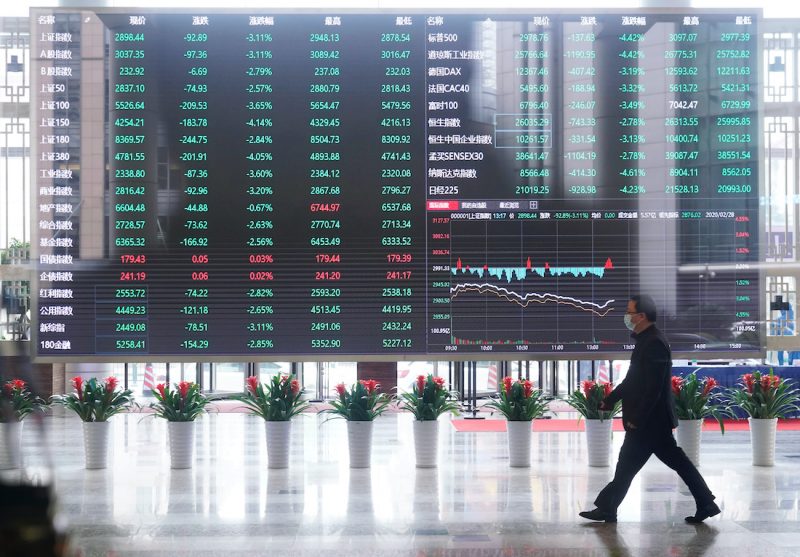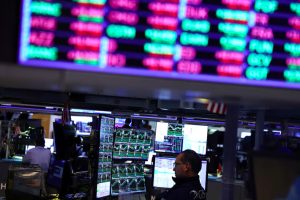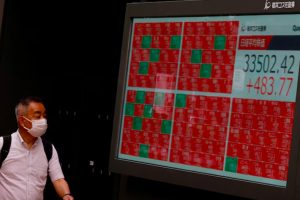Asian stocks suffered on Tuesday, trailing in the wake of a Wall Street slide and weighed down by interest rate threats and China’s deepening Covid situation.
Wall Street dived with the tech-rich Nasdaq plummeting more than 4%, while the S&P 500 ended below 4,000 points for the first time since March 2021.
That saw Asian equities slip to their lowest in nearly two years overnight, before trimming their losses later in the day.
A sharp fall in China’s April exports, sparked by Beijing’s zero-Covid policy that has placed millions under lockdown, and ongoing uncertainty over the war in Ukraine have spooked traders.
Also on AF: China Docks Cargo Spacecraft As it Eyes First Space Station
Hong Kong equities ended lower after a late recovery following an opening plunge after Wall Street’s rout the day before.
The Hang Seng Index dropped 1.84%, or 368.27 points, to 19,633.69. The Shanghai Composite Index rose 1.06%, or 31.70 points, to 3,035.84, while the Shenzhen Composite Index on China’s second exchange saw a 1.53% bump, or 28.47 points, to 1,894.39.
Tokyo shares closed lower, weighed down by Wall Street uncertainty and concerns over China’s slowing economy.
The benchmark Nikkei 225 index dipped 0.58%, or 152.24 points, to end at 26,167.10, while the broader Topix index fell 0.85%, or 16.01 points, to 1,862.38.
Indian stocks dropped back too, with Mumbai’s signature Nifty 50 index down 0.38%, or 61.80 points, to close at 16,240.05. Slumps seen in Seoul, Wellington, Singapore and Jakarta later eased.
MSCI World Index Flat
European stock indexes opened higher, with risk appetite showing some recovery after Monday’s sharp falls, but analysts said fears over lower growth were still weighing on markets.
The MSCI world equity index, which tracks shares in 50 countries, was trading flat, having touched its lowest since late 2020 earlier in the session.
Europe’s STOXX 600 was up 0.8%, but the gain was small relative to its 6.6% loss so far in May. S&P 500 futures were up around 0.8% while Nasdaq futures rose 1.3%.
Peter McCallum, an interest rates strategist at Mizuho, said the bounceback was a natural correction after the previous session’s falls. Traders could also be positioning themselves to take advantage of any boost to sentiment coming from Wednesday’s key US consumer price index (CPI) data, he said.
“If headline inflation comes in and shows that month-on-month CPI is heading in the right direction then that makes the case for potentially a more dovish Fed and hikes being priced out,” McCallum said.
Australian Dollar Hits Two-Year Low
The dollar index was little changed, having reached a 20-year high on Monday. Meanwhile, the Australian dollar fell to its lowest in nearly two years, hurt by fears of slowing economic growth.
Oil prices edged higher, recovering after steep declines on Monday, which were due to a combination of the stronger dollar, growing recession fears, and Covid lockdowns in China.
The US 10-year yield was at 3.0499%, having eased since it hit 3.203% on Monday – a level not seen since 2018.
Gold also went some way to recover Monday’s decline, up around 0.4%.
Elsewhere, Bitcoin was up 5.5%, recovering some of its 11.6% plunge on Monday, its biggest daily fall since May 2021. At around $31,736, the cryptocurrency has lost more than half its value since it hit an all-time high of $69,000 in November.
Key figures
Hong Kong – Hang Seng Index > DOWN 1.8% at 19,633.69 (close)
Shanghai – Composite > UP 1.1% at 3,035.84 (close)
London – FTSE 100 > UP 0.7% at 7,264.15
Tokyo – Nikkei 225 > DOWN 0.6% at 26,167.10 (close)
Brent North Sea crude > DOWN 0.2% at $105.72 per barrel
West Texas Intermediate > DOWN 0.1% at $102.97 per barrel
New York – Dow > DOWN 2.0% at 32,245.70 (Monday close)
- Reuters with additional editing by Sean O’Meara
Read more:
China Should Meet 5.5% Growth Target, People’s Daily Says
Crypto Fear and Greed Index Now in ‘Extreme Fear’ Territory
























